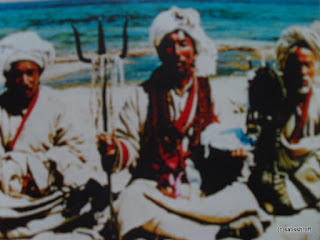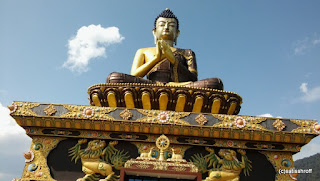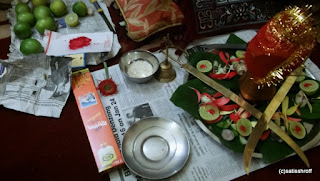Healers in the Himalayas (Satis Shroff)A Poem by Satis ShroffIt’s not easy to meet a shaman, Unless you know someone who does. Drove in a taxi to Tibet Road..My Tryst With Healers in the Himalayas (Satis Shroff)It’s not easy to meet a shaman, Unless you know someone who does. Drove in a taxi to Tibet Road, Then to the Mohandas Karamchand Gandhi Marg, And ended in Chaangaon, In the Gangtok suburb. The bongthing I met, Had grown old and sick. He showed me his cardiac capsules and pills, On the palm of his big hand. He was grateful that his daughter looked after him. He advised I should go to another, A bongthing in the neighbourhood. A Bhutia woman was selling sausages and sweets. The fat sausages hung on strings from the ceiling. Ah, it’s so good to hear Nepali being spoken, Where ever you go in Sikkim. I asked myself whether I was in Nepal? Sikkim was once Nepali, Now it belongs to West Bengal. The Bengalis speak of ‘Amar shonar Bongal, And in the same breath ‘Amar Konchonjonga!’ When they come to Darjeeling during the tourist season. The Sikkimese Kanchanzonga is controlled from Delhi, And enjoys privileges that Darjeeling can only dream of. That was the price of democratization of the Kingdom of Sikkim. The Chogyal of Sikkim and his love and hope Were deprived of their Chogyaldom by a fierce Indira Gandhi, Who wanted no nonsense in the sensitive Himalayas. Some Gorkhalis from Gorkhaland dream of being united with Sikkim, Rather than Kolkotta. Like the Mun and Bongthing, The Lepcha yukmuns (lamas) are facing extinction. The religion of the Lepchas of Sikkim resembles The pre-Buddhist faith of Tibet called Pon (Bon-religion). Tibetan Buddhism dates back to the 8th century. The architect of tantric Buddhism Padmasambhava Is known to have sojourned in Sikkim, On his way to Tibet. Red hat Buddhists fled to Sikkim, And speedily converted the Lepchas. Most Buddhist Lepchas today practice animism. The service of the muns are needed by the Lepchas At birth, marriage and during death ceremonies. The Lepcha language is called Rongring. A German named Mainwaring went Native, Lived with the Lepchas and studied their language. He came to a conclusion that Lepcha Was the oldest language extant. Belief and faith is perpetuated by a chain of rituals. ‘Religion is belief in spiritual being’ said Taylor back in 1871. Mathew Arnold came up with: ‘Religion is morality touched with emotion.’ If religion is a superstructure it is man Who doesn’t realize the complexities of the cosmos. The Lepchas believe in spiritual being, A religion which believes in the continuation of the soul, Even after the death of the carcass called the body. You find the soul in trees, rocks, rivers, hills and animals. Where there is good there is evil. Evil spirits abound in rocks, lakes, mountains Are constantly out to do mischief. You are obliged to pray to them for they hurt us, If we don’t. These malevolent spirits are called Moong. The Lepchas believe in one supreme God And other Gods and Goddesses. Some spirits are good (sukyo rum) and bad (aami-moong). The evil spirit aami-moong gets ferocious When someone trespasses a garden or orchard. The evil spirit can paralyse someone. The bongthing took his time for a séance. His pretty wife organized the ritual objects. A metal plate, red rice corns, flowers. Then he began to pray and recite. It was a long monologue, With all the Gods and goddesses and Spirits, Beckoning, greeting, pleading and cajoling them, To heal the patient. The shaman’s monologue was carried out In a falsetto voice at high speed, Interspersed with hyperventilation That involved one deep inspiration And three forced expirations, At the end of each recitation. I greet you the Gods of the Five Treasures of the Snow, I greet Shiva and Parvati who live in the Snow. I greet Hanuman and Ganesh. I greet the Gods from the snow capped peaks, The spirits from the plunging waterfalls, The spirits at the confluence of the Rangit and Teesta rivers. I beckon the Gods and Spirits of the Lachenpas, God Kirateswary and the twelve Jyotilingas And Sai Baba. Throughout the ritual the rice corns were moved in small clusters, Gathered and dropped gently over the effigy of the main God in question, Which was symbolised by a metallic vase, Filled with flowers. The shaman touched the patient’s head With a crude broom made of leaves, To bless the head and shoulders of the patient. At the end of the séance the bongthing said: ‘There is nothing wrong with this patient. A naag is running after him, So I’ll have to do a puja. Thereafter, he’ll get a charm with a mantra, Which he’ll have to carry around his neck For the rest of his life. The patient thanked him profusely And the patient and his sisters left for Gangtok In their Bolero jeep. Glossary: Jyoti: light Lingas: lingam, a well-polished sedimentary stone symbolizing Shiva. bongthing: Lepcha shaman, traditional healer Naag: serpent Puja: ritual ceremony © 2016 Satis Shroff |
Stats
190 Views
Added on March 23, 2016 Last Updated on March 23, 2016 Tags: himalayas, bongthing, jhakri, ban-jhakri, sikkim, gangtok, nepali, lepcha, bhutia, yeba limbus, tamang jhakris AuthorSatis ShroffFreiburg, Baden-Wuerttemberg, GermanyAboutI'm a German of Nepalese descent based in Freiburg, and have worked in Kathmandu(Nepal) as a features journalist (The Rising Nepal) and wrote commentaries for Radio Nepal. before coming to Germany for.. more..Writing
|






 Flag Writing
Flag Writing